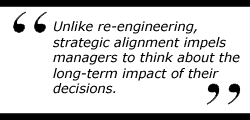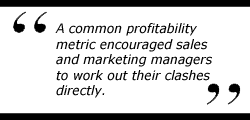In a Slump? Realign, Don't Re-Engineer
When recession looms, companies typically turn to layoffs for short-term relief, but this rarely improves long-term performance. This time, shake up your organizational model to improve efficiency.
(originally published by Booz & Company)It's the corporate rage this spring: The moment companies post poor earnings results, they rush to lay off employees and cut costs. For firms like Xerox and Whirlpool, layoffs are a familiar response to inevitable (but never really anticipated) cyclical downturns. Indeed, nearly half the 804 executives at U.S. firms surveyed last month by the American Management Association say their companies will not meet revenue targets set at the beginning of the year, and 64 percent have already cut jobs and imposed hiring freezes.
But this season also marks the first crash of some high-tech high-fliers accustomed to fast growth rather than sudden deceleration. In mid-April, Cisco Systems announced that third-quarter revenues would be 30 percent lower than second-quarter revenues, and that it would write off $2.5 billion in inventory and cut 8,500 positions.

Executives taking this knee-jerk approach will soon discover that announcing a layoff is the easy part. The hard part is deciding which positions (and people) to eliminate. And harder still is getting work done effectively after those people are gone.
The last time companies faced this issue in the early 1990s, the solution of choice was re-engineering, a tool popularized as a way to "radically transform" work processes and deliver "quantum improvements" in performance, according to the 1993 book Re-Engineering the Corporation. Unfortunately, the promise of re-engineering did not match the results. Usually, excised costs and personnel gradually returned once the pressure for change dissipated, leaving organizations inefficient and overstaffed — again.
Despite its record, re-engineering is still around, in practice if not in name. Unless executives deliberately select a fundamentally different approach to change, many of them will be forced to rely on the frameworks and assumptions of re-engineering, the only way they know to make an organization run with fewer resources. The results likely will be the same as the last time — some short-term improvement, but no lasting change in performance or costs.
Executives can break out of the rut with an organizational model we call "strategic alignment." Unlike re-engineering, this new model does not impose rigid processes on organizations. Instead, it creates a corporate environment where organizational elements — such as structure, processes, objectives, measures, and incentives — lead managers to make decisions that improve financial and operating performance. Strategic alignment impels managers to work out the tensions that result in redundant staff and underperformance.
Rethinking the Organization
The logic of strategic alignment becomes clear when contrasted with the failed philosophy of re-engineering. At its heart, re-engineering was based on the century-old theory of Frederick Winslow Taylor, that variation is waste. His followers sought to root out variation by routinizing, and if possible automating, core business processes. This approach makes sense when applied to clerical, easily measured work, like insurance claims processing and call-center operations.
But this process-oriented approach breaks down in cases where individuals must make decisions based on their own information, judgment, and experience. The inevitable variations lead to tensions that cannot be resolved by re-engineering. A classic example is the clash between sales and manufacturing. Sales managers want a broad product line that gives them more ways to close a sale, but manufacturing managers want a limited product line to gain economies of scale. Left unresolved, the tension will lead to discontent and turf wars that can't be wished away or settled by rigid decision rules or processes. Typically, neither side has the "right" answer, because these are not simple, either-or situations. Further, the solution likely will vary over time as customers, competition, and technologies change.

Why Re-Engineering Failed
Given this context, re-engineering's shortcomings become obvious. Some might argue that re-engineering was a victim of its own success. As it gained in popularity, it became associated with the 1990s' massive layoffs, rather than with its original purpose of reshaping processes. But re-engineering's flaws go beyond poor execution, to its oversimplification of how organizations work. Its bias toward static, written rules means it cannot handle the abstract, dynamic thinking and actions of humans in a knowledge economy. Re-engineering is based on the view that outsiders could improve dramatically the processes that engaged insiders painstakingly built over years or decades. Most important, it underestimates personal motivation as an influence on the individuals' decisions.
Strategic alignment avoids these traps through two simple premises:
- Managers are rational actors. Managers make decisions based on the incentives, constraints, and information in their environment.
- The organization is a dynamic system. An organization's elements constantly blend together and have impact on rational managers. Change the elements and you change the basis for decisions.
Unfortunately, most executives struggle with their organizational design. First, the complexity is daunting, with thousands of design decisions to be made across organizational units. Second, mid- and lower-level managers lack a broad view because they are biased by their functional roles. Third, senior managers who can see the big picture lack the time to consider deep-rooted changes. Finally, many managers frame problems in terms suitable for a quick fix (hence, re-engineering's popularity). With focused effort, it's almost always possible to improve a single aspect of organizational performance, but anything less than a system-level realignment will result ultimately in poorer resource allocation, missed opportunities, and sharper internal friction.

Aligning an organization is arduous, but the payoff can be substantial. We recently worked with a consumer packaged-goods company that never hit its profit targets despite waves of overhead reductions. Whatever the technique or logic, the long-run results were the same: The headcount always rose to earlier levels. Executives kept cutting the same positions over and over again.
The root cause was a tension that arose because the company was simultaneously managed along brand and channel dimensions. The unresolved conflict for control led to poor use of scarce marketing resources, both people and funds. Managers from both sides added staff to corporate headquarters in a misguided attempt to reconcile the two competing views of the business.
We helped the company create an organizational model that, first, acknowledged this inherent complexity, and, second, deployed mechanisms to manage the frequent trade-offs between brands and channels. The company restructured decision rights, introduced new planning and budgeting processes, and allowed overlapping views of profitability (previously, a single person "owned" the P&L). Before long, marketing funds were allocated for strategic and factual, rather than political, reasons. More important, a common profitability metric encouraged sales and marketing managers to work out their clashes directly, without constant intervention by middle managers. Indeed, these middle managers lost much of their organizational purpose once they were no longer needed to second-guess other managers. As a result, the retooled organization eliminated most of this layer of middle management, further enhancing efficiency and lowering headcount.
Embrace Complexity
As senior managers grapple with the current economic turmoil, they will be tempted to re-engineer. Yet, even as they dismiss employees, they will have no sure idea of how to untangle the organizational knots that foster overstaffing and inefficiency in the first place. In our view, the temptation should be resisted, strongly, since re-engineering will not work any better the second time around.
Unlike re-engineering, alignment does not promise an easy fix. It does not micromanage employees, demanding they use the one best way to do things. Instead, its system-wide, iterative approach balances competing forces so the right decisions are made naturally and logically. As circumstances change — through acquisitions, new technologies, shifts in strategy — the system rebalances. As shown in the consumer packaged-goods example, getting the alignment right will provide benefits beyond the reach of re-engineering.
| Authors
Jeffrey W. Bennett, bennett_jeffrey@bah.com Jeffrey W. Bennett is a vice president in Booz-Allen & Hamilton’s Cleveland office. He has helped clients in multiple industries redesign their organizational models to achieve rapid, dramatic improvement in performance. Steven B. Hedlund, hedlund_steve@bah.com Steven B. Hedlund is a principal in Booz-Allen & Hamilton’s Cleveland office, focusing on organizational and strategy-based transformation for automotive, aerospace, and industrial companies. |

